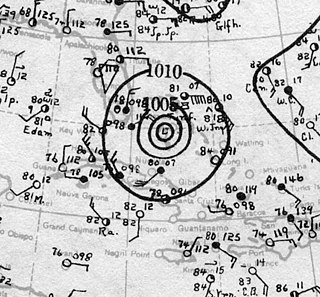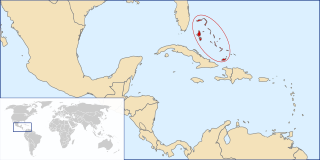
The Bahamas, known officially as the Commonwealth of The Bahamas, is a country within the Lucayan Archipelago of the West Indies in the Atlantic. It takes up 97% of the Lucayan Archipelago's land area and is home to 88% of the archipelago's population. The archipelagic state consists of more than 700 islands, cays, and islets in the Atlantic Ocean, and is located north of Cuba and northwest of the island of Hispaniola and the Turks and Caicos Islands, southeast of the US state of Florida, and east of the Florida Keys. The capital is Nassau on the island of New Providence. The Royal Bahamas Defence Force describes The Bahamas' territory as encompassing 470,000 km2 (180,000 sq mi) of ocean space.

Andros Island is an archipelago within the Bahamas, the largest of the Bahamian Islands. Politically considered a single island, Andros in total has an area greater than all the other 700 Bahamian islands combined. The land area of Andros consists of hundreds of small islets and cays connected by mangrove estuaries and tidal swamplands, together with three major islands: North Andros, Mangrove Cay, and South Andros. The three main islands are separated by "bights", estuaries that trifurcate the island, connecting the island's east and west coasts. It is 167 kilometres (104 mi) long by 64 km (40 mi) wide at the widest point.

Grand Bahama is the northernmost of the islands of the Bahamas, with the town of West End located 56 nautical miles east of Palm Beach, Florida. It is the third largest island in the Bahamas island chain of approximately 700 islands and 2,400 cays. The island is roughly 530 square miles (1,400 km2) in area and approximately 153 kilometres (95 mi) long west to east and 24 kilometres (15 mi) at its widest point north to south. Administratively, the island consists of the Freeport Bonded Area and the districts of East Grand Bahama and West Grand Bahama. Nearly half of the homes on the island were damaged or destroyed in early September 2019 by Hurricane Dorian.

Eleuthera refers both to a single island in the archipelagic state of The Commonwealth of the Bahamas and to its associated group of smaller islands. Eleuthera forms a part of the Great Bahama Bank. The island of Eleuthera incorporates the smaller Harbour Island. "Eleuthera" derives from the feminine form of the Greek adjective ἐλεύθερος (eleútheros), meaning "free". Known in the 17th century as Cigateo, it lies 80 km east of Nassau. It is long and thin—180 km long and in places little more than 1.6 km wide. Its eastern side faces the Atlantic Ocean, and its western side faces the Great Bahama Bank. The topography of the island varies from wide rolling pink sand beaches to large outcrops of ancient coral reefs, and its population is approximately 11,000. The principal economy of the island is tourism.

Cat Island is located in central Bahamas, and is one of its districts. Cat Island also has the nation's highest point, Mount Alvernia. It rises to 206 feet (63 m) and is topped by a monastery called The Hermitage. This assembly of buildings was erected by the Franciscan "Brother Jerome".

Freeport is a city, district and free trade zone on the island of Grand Bahama of the northwest Bahamas. In 1955, Wallace Groves, a Virginian financier with lumber interests in Grand Bahama, was granted 20,000 hectares of pineyard with substantial areas of swamp and scrubland by the Bahamian government with a mandate to economically develop the area. Freeport has grown to become the second most populous city in the Bahamas.

Inagua is the southernmost district of the Bahamas, comprising the islands of Great Inagua and Little Inagua. The headquarters for the district council are in Matthew Town.

Manilkara zapota, commonly known as sapodilla, sapota, chikoo, chico, naseberry, or nispero is a long-lived, evergreen tree native to southern Mexico, Central America and the Caribbean. An example natural occurrence is in coastal Yucatán in the Petenes mangroves ecoregion, where it is a subdominant plant species. It was introduced to the Philippines during Spanish colonization. It is grown in large quantities in India, Pakistan, Thailand, Malaysia, Cambodia, Indonesia, Vietnam, Bangladesh and Mexico.

East Grand Bahama is a district of the Bahamas, situated on the eastern part of the island of Grand Bahama.

South Andros is a district of the nation of the Bahamas.

North Andros is one of the 31 districts of the Bahamas. It is also the largest district in the country. It has some of the largest settlements on Andros Island and many churches as well. The population is 3,898.

The 1929 Bahamas hurricane was a high-end Category 4 tropical cyclone whose intensity and slow forward speed led to catastrophic damage in the Bahamas in September 1929, particularly on Andros and New Providence islands. Its erratic path and a lack of nearby weather observations made the hurricane difficult to locate and forecast. The storm later made two landfalls in Florida, killing eleven but causing comparatively light damage. Moisture from the storm led to extensive flooding over the Southeastern United States, particularly along the Savannah River. Across its path from the Bahamas to the mouth of the Saint Lawrence River, the hurricane killed 155 people.

The Antillean fruit-eating bat is one of two leaf-nosed bat species belonging to the genus Brachyphylla. The species occurs in the Caribbean from Puerto Rico to St. Vincent and Barbados. Fossil specimens have also been recorded from New Providence, Bahamas.

The following is an alphabetical list of topics related to the Commonwealth of The Bahamas.
The Sapodilla Cayes are an uninhabited atoll in the Gulf of Honduras. They are in the Toledo District of Belize.
Bahamian Cuisine is to the foods and beverages of The Bahamas. It includes seafood such as fish, shellfish, lobster, crab, and conch, as well as tropical fruits, rice, peas, pigeon peas, and pork. Popular seasonings commonly used in dishes include chilies, lime, tomatoes, onions, garlic, allspice, cinnamon, rum, and coconut. Rum-based beverages are popular on the islands. Since the Bahamas consist of a multitude of islands, notable culinary variations exist.
The Gales Point Wildlife Sanctuary is in the Belize District approximately 23.7 southwest of Belize City and 34 km north of Dangriga. The Sanctuary includes Southern Lagoon, Sapodilla Lagoon, Western Lagoon, Quashie Trap Lagoon and a portion of the Manatee river. It has a shoreline of 66-foot that is along all the lagoons and waterways except for the peninsula. The Wildlife Sanctuary covers a complex matrix of creeks, mangroves, mudflats and brackish lagoons. Both the rivers and creeks drains into the lagoon from the west. The lagoon is also connected to the Caribbean Sea via the Bar River.

Manilkara jaimiqui, commonly known as wild dilly, is a woody plant in the sapodilla family. It is native to tropical regions of North America, where it is found in the West Indies and south Florida. Its natural habitat is areas of coastal hammocks and pine rocklands.















